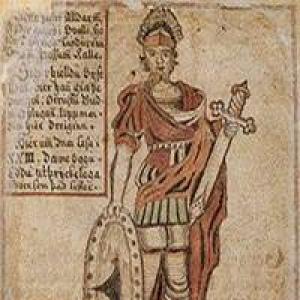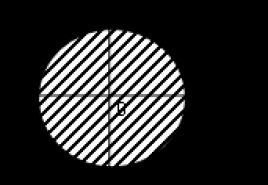Constellation Perseus and Gorgon Medusa. Earthlings have only one night left to make a wish
Map starry sky- the sight is incredibly attractive and mesmerizing, especially if it is a dark night sky. Against the background of the Milky Way stretching out on a foggy road, both bright and slightly dim stars that make up various constellations are clearly visible. One of these constellations, almost entirely located in the Milky Way, is the constellation Perseus.
Legend of the constellation Perseus
The constellation Perseus (the legend of whose origin is extremely beautiful) is quite interesting from a scientific point of view. But now it’s not about that, but about love. The constellation resembles a man with a high hat on his head. And this is the story about the constellation. According to ancient legend, Perseus was the illegitimate child of Zeus and the king's daughter. At one time, a prophecy was revealed to the ruler that he would die at the hands of his own grandson. Frightened by the prediction, the king locked the beautiful Danae in the tower. But Zeus, who fell in love with an earthly girl, snuck into the dungeon, turning into golden rain. Soon the princess gave birth to a son. And in order to get rid of the unwanted baby, the king ordered the mother and baby to be imprisoned in a barrel and thrown into the sea. The young mother and baby survived, but the barrel floated to the shore of the island.
When the young handsome Perseus became an adult, he accomplished many feats. And during his adventures, the young man found his love - the beautiful Andromeda. Already as an adult, he took part in discus throwing competitions, where he accidentally killed his grandfather. Here is such a beautiful story about a constellation with a slightly sad ending.

History of the ancient constellation
The constellation Perseus, located in the northern celestial hemisphere, was discovered by ancient astronomers. And it is best visible in the starry sky from November to March. On a cloudless and moonless night, it will not be difficult to distinguish all ninety stars of the constellation, even naked eye, since the constellation contains stars of both second and third magnitude.

Second variable star
In the constellation Perseus, in addition to Algol, there is another variable star. It can also be observed without a telescope. The time range of its flickering is not constant, like that of the “devil” star, but falls within the range from 33 to 55 days. This phenomenon of inconstancy has not been fully studied by astronomers, just as the cause of the flickering has not been determined.
This one is a pleasure to watch. But since scientists are accustomed to combining business with pleasure, it was found that this star also has a satellite. Moreover, its dimensions are somewhat smaller than the size of the star itself.
Observing this pair through a telescope, astronomers called them “celestial diamonds” because of the amazing combination of colors. The main star glows with a beautiful orange light, while its small companion has a mysterious bluish glow.
Perseus meteor showers
For those who are actively interested in meteorites, astronomers offer to watch the fascinating spectacle of meteor showers in the constellation Perseus. There is a meteor shower during the summer time. This is from approximately mid-July to the last days of August. Peak rainfall occurs in mid-August. Astronomers named this active meteor shower the Perseid.
In the night sky you can see a huge number of wonderful constellations, many of which still require careful study and consideration. This also applies to the constellation Perseus. Despite many discoveries, many generations of people still have to study it. What still remains far “behind the scenes” of modern astronomical science, perhaps in a few decades will amaze humanity with the scale of its discovery.
Welcome to the knight!
Double Cluster and Heart Nebula
Perseus outwitted the gorgon Medusa, and then (on the way to Pegasus) saved Andromeda, the daughter of Cepheus and Cassiopeia, from Keith. We see this story of his overhead in the evenings of early winter.
We have told the legend in an abbreviated form, now let's move on to consider some of the goals for visual observers in Perseus.
| Object | Type | Size | Sv.vel | R.A. | Dec | |
| Object | M 34 | OCL | 25.0" | 5.2 | 02h 42m 37.3s | +42 47" 55" |
| M 76 | PNeb | 3.1" | 10.1 | 01h 42m 49.8s | +51 36" 54" | |
| Mel 20 | OCL | 185.0" | 1.2 | 03h 22m 35.6s | +49 01" 51" | |
| NGC 869 | OCL | 18.0" | 5.3 | 02h 19m 39.3s | +57 10" 29" | |
| NGC 884 | OCL | 18.0" | 6.1 | 02h 23m 07.8s | +57 11" 00" | |
| NGC 1023 | GLX | 7.4"x2.5" | 9.5 | 02h 40m 55.5s | +39 06" 01" | |
| NGC 1058 | GLX | 2.5"x2.5" | 11.2 | 02h 44m 01.1s | +37 22" 41" | |
| NGC 1245 | OCL | 10.0" | 8.4 | 03h 15m 16.1s | +47 16" 14" | |
| NGC 1342 | OCL | 17.0" | 6.7 | 03h 32m 12.5s | +37 24" 14" | |
| NGC 1491 | BNeb | 25.0"x25.0" | 04h 03m 51.4s | +51 20" 23" | ||
| NGC 1513 | OCL | 12.0" | 8.4 | 04h 10m 31.8s | +49 32" 23" | |
| NGC 1528 | OCL | 18.0" | 6.4 | 04h 15m 56.9s | +51 13" 58" | |
| NGC 1545 | OCL | 12.0" | 6.2 | 04h 21m 34.0s | +50 16" 32" | |
| Complex | Abell 426 | GLX CL | 252.0" | 13 | 03h 20m 15.2s | +41 31" 53" |
| objects | IC 351 | PNeb | 18" | 11.9 | 03h 48m 05.2s | +35 04" 27" |
| IC 2003 | PNeb | 20" | 11.4 | 03h 56m 54.0s | +33 54" 04" |
Perseus has a little bit of everything. It is located on both sides of the winter Milky Way, so you'd expect an abundance of open clusters and reflection nebulae, but there's something else here - a fair share of galaxies. According to the Sky Tools 2 database (admittedly incomplete), there are 8,445 galaxies, 10 Abel galaxy groups, 19 quasars, 23 planetary nebulae, 7 diffuse nebulae, 42 dark nebulae, and 35 open clusters. This is truly an amusement park for astronomy lovers! 

Mel 20 - Roni de Laet at 9x
In the center of Perseus we will find the moving cluster Alpha Persei. This cluster, also known as Mel 20 And Collinder 39, is huge - over three degrees across, and to my taste looks best to the naked eye or at low magnification. Cutting through the wintry Milky Way, Mel 20 is an inspiring sight, especially with the weakest optics.

California Nebula and M45 - Boris Stromar
The next target is a complex object; it remains in my memory as an “independent” discovery that I made while sketching Comet Hale-Bopp more than 10 years ago. This is an easy goal for a photographer, but a difficult goal for a visual artist. I'm talking about NGC 1499 - California nebula. It is so named because of its shape, but its photographs are somewhat deceiving to the visual observer. This is a huge target (about 3 by 2/3 degrees), it has a 5th magnitude, but has an extremely low surface brightness, making it very difficult to locate. It is best to use either a small telescope with a wide field of view or binoculars, or view it with the naked eye in a very dark area. In “wide-angle telescopes” it appears as just a slight clearing of the stellar background. Some observers have reported positive results from using the H-beta filter.
No discussion of Perseus would be complete without mentioning Algol- demonic star. Algol is located about 93 light years away and is an eclipsing binary. Every 68 hours and 45 minutes, Algol's larger but dimmer second companion eclipses its smaller but brighter first by 79%. Over the 10 hours that this continues, Algol dims from 2.12 to 3.39. Algol is actually a triple star system, but the apparent "variability" is caused by the interaction of only these two. It is quite interesting that there was, in all likelihood, a flow of matter between these stars. One of the stars filled the teardrop-shaped region between itself and its companion (called a Roche lobe) and transferred material above the Lagrange point. Unfortunately, we can only imagine how exciting it must have looked.
The famous Double Cluster will be a spectacular target for an observer with the weakest optics.
NGC 869/884

These two independent clusters are easily visible to the naked eye in semi-rural areas and appear to have been known from very ancient times, having been recorded by both Hipparchus and Ptolemy. The pair are a fascinating sight, and novice observers often stumble upon them while playing "What's that foggy thing?" I myself did this in my youth, almost a year before I had anything in my possession that could tell me what I had discovered. The double cluster brings back special memories for me, and I suspect many of you can say the same. It was one of the first telescopic objects that made my jaw drop, and subconsciously my feelings when I first saw this object are inextricably linked with my first look at Saturn.

Double Cluster - Eric Jacob
Classically, the clusters were often referred to as h and X Persei, but Archinal and Hinis note that O'Meara and Green demonstrated that these labels arose when Bayer designated two objects as such in his Uranometria. Archinal also mentions that today there is reason to believe that by X Bayer meant the light of both clusters.
It seems to me that this goal looks most advantageous through a telescope with a wide field of view. I've seen it countless times over the years, but the best views came from the NP101 with a 13mm Nagler eyepiece (and later a 13 Ethos). This combination gives a magnification of 42x and a field of view of almost 2 degrees (2.5 with the Ethos eyepiece). With this combination, the stars appear as tiny diamonds scattered across the night sky. While you're looking, take a moment and look for the dark red pearl at the heart of 884. This is a semi-regular RS Perseus variable with a period of 224 days. It changes magnitude from 7.8 to 10.0.
Here's what Roger Raubach provided: « This is not the result of one observation, but general impressions of this magnificent gemstone. I've looked at the Double Cluster - NGC 869 and NGC 884 - in many telescopes. The most memorable view came on a frosty evening in December 2003 with my then-new Takahashi TOA 130. The Double Cluster looked best at 29x magnification through a Panoptic 35 eyepiece, which showed two small balls of stars appearing to float in the rich background of the winter Milky Way. I've seen the Double Cluster before in the Celestron C 9.25 and C 14, but neither of those views compares to the pristine beauty of the wide-angle image produced by the small refractor.".
Moving 8 degrees southwest of the binary cluster, we arrive at our first Messier object in Perseus.

M76

This small planetary nebula shows some structure even in small telescopes and has not one, but two NGC designations (650 and 651). Most telescopes show two planetary lobes with a dark area separating them. For a small telescope this is a small but interesting object. At low magnification, you will need to be careful when examining the area, because It's pretty easy to get past.
Looking through a large telescope will make your jaw drop. I first observed M76 in a large telescope with my friends, in their 20-inch instrument. I'm not in the habit of looking at Messier through a large aperture, and they didn't tell me what the target was - they preferred to see if I recognized it on my own. I was floored to find THIS instead of the tiny M76 nut I was used to seeing.

M76 - Bill Warden Every centimeter of aperture increases the amount of detail seen in that object. At small apertures it looks like a peanut, somewhat reminiscent of the M1. As the aperture increases, it becomes a rectangular strip of light. In even larger telescopes, I saw (with direct vision, by the way) handles / wings, which are characteristic of photographs no less than the richness of detail. Oddly enough, even though it's a planetary nebula, I don't have to use the OIII filter, and I usually see more detail without any tricks.
As O'Meara notes (Messier Objects), M76 is the same true size as M27, but is about 5 times further away.
I'm not entirely clear why, but M76 seems to have gained a reputation for being the most difficult on Messier's list. Of course, there are some things that work against it: it's small size, somewhat isolated position (but not entirely), and the fact that it's a little dim compared to most of its peers. But believe me, that's not all that makes the goal difficult.

NGC 1245

But let's return to Perseus as such and move down his body. Just southwest of Mel 20 we come across NGC 1245. In my 4-inch apochromat at 45x, it's a fairly small cluster. It is visible as a foggy haze between three bright stars and becomes clearer when using peripheral vision. Adding magnification helps to detect more and more cluster members, which is also helped by increasing the aperture. I like to use as low a magnification as possible on open clusters - this is best for the aesthetic appeal of the image. Due to light pollution in the sky, Bill Worden was unable to observe with his 80mm f5 telescope, but he sent the following digital image.

NGC 1245 - Bill Worden
Now let's move east of Mel 20, to Lambda Perseus. There are three open clusters of interest here and an emission nebula.

NGC 1491

Although it is listed in the catalogs as a bright nebula, I was not able to fully pull it out in a 4" telescope, but I cleverly spotted it at 18" as a fairly bright, semi-triangular glow. Try an OIII or UHC filter on it and see what happens.
NGC 1513

In the 4-inch telescope it was a dim, rather unremarkable cluster, which at the best moments, at the limit of peripheral vision, was resolved into about a dozen stars. Large telescopes show it a little more advantageously and at a maximum of 25–35 stars.
NGC 1545

4 inches shows a diffuse haze surrounded by a bright triangle of stars. Try to see the color of these stars, which are mostly located against the background of the glow. Overall, I found the view to be quite interesting for a small telescope, with geometric patterns that draw the eye again and again. For my taste, the best views were obtained with the Ethos 42x eyepiece. Try viewing NGC 1545 and its larger but fainter companion NGC 1528 (which lies about a degree to the northwest) in the same field of view with a wide-field telescope.

NGC 1545 - Juha Ojanpera, 11" 69x
NGC 1528

It is considered slightly dimmer than 1545, but appears aesthetically a little more pleasing to me in my 4-inch apochromat, showing much greater resolution upon close inspection. When using averted vision, glimpses of dozens of stars appear, and the attractive field invites detailed inspection. Look for arcing chains of stars radiating in different directions from the central point of the cluster.

NGC 1528 - Juha Oyanpera, 11" 69x
Here's what a reader under the nickname Zizzapnia writes: (binoculars, 4.5 inches) Visible through binoculars as a dim spot. Large and sparse. Half a degree in diameter. A triangle of 7th magnitude stars dominates. (10 inches) At 62x there's a nice cluster that's interesting in detail. Roughly triangular in shape with dark alleys on the surface. A bunch of stars with magnitude 10.5 or fainter. Quite a lot of groups of stars, 4–6 stars in about 6 clusters, including the main cluster.
Let's go to the last part of the sky for this evening. Here we will have many targets: clusters, galaxies, as well as our complex objects.

M34

M34 - Eric Jacob
M34 is a fantastic cluster for small telescopes and binoculars and can be seen with the naked eye in dark environments. I have never liked looking at large clusters with too much magnification: if you stretch the view too much, part of the impression will be lost. M34 is an exciting picture.

Roger Raubach provided the following: From my notes from 01/23/2004. “Easy binocular target; easily stands out when scanning the sky from Almach to Algol. The stars are easily resolved at 8x in the IOR Bucharesti 8x40 binoculars. At TOA 130mm at 29x the cluster resolves into a beautiful collection of bright blue-white stars. I also noted a pronounced double Struve 44 near the center of the cluster. Even at 29x the telescope almost ruins this object. It's probably best to look through large binoculars mounted on a tripod." I will add that several times, on very clear dark nights, I could pick it out with the naked eye.

M34 – Carol Lakomiak
NGC 1023

Dropping 3 and 2/3 degrees almost due south of M34, we encounter the brightest galaxy in Perseus, NGC 1023. This bright galaxy is an SBO, which means it is a spiral galaxy with a central bulge and no arms. Recent analysis using data from the Hubble Space Telescope and various Earth-based telescopes has shown signs of a supermassive black hole at the core - one of those that is pulling stars (already captured) into its disk at an estimated speed of 1.3 million miles (2 million km). ) per hour.

NGC 1023 - WadeVC
My notes indicate that this is an easy target for a 4-inch apochromat with a 12mm Nagler (45x) eyepiece. At this aperture it's just a blurry light, perhaps with some brightening towards the center, but showing virtually no detail. In an 18" telescope, differences in light become noticeable. Closer to the middle, the light becomes brighter, and a long inspection reveals a pronounced core and almost stellar core.
Here's what reader Zizzapnia writes: (4.5 inches) Nice, fairly bright, star-shaped core. There are many stars of 8th to 9th magnitude nearby. It is located almost edge-on, oriented from east to west. Elongated by approximately 5 arcminutes. Visibility of the halo surrounding the core is poor at 180x. The eastern part of the halo is slightly brighter than the western part and extends a little further. Two degrees south-southwest and we find a more difficult inhabitant of the galactic zoo:
NGC 1058

It can, of course, be seen in a medium-sized telescope, but it's not nearly as impressive as 1023 - unless you looked at it that summer when supernova 2007GR was discovered ( note: in August 2007). Another one broke out in 1961. You should definitely include this galaxy in your supernova search program. Usually (on a night without supernovae) this is only a semi-dim, diffuse glow 2" in size, showing no hint of increased brightness in the center.
NGC 1342

Now let's move 9.5 degrees east of 1058 and find a small open cluster NGC 1342. The 4-inch telescope shows approximately a dozen or two stars. Luginbühl and Skiff in the Observing Handbook and Catalog of Deep-Sky Objects mention that this cluster resembles a stingray swimming westward. True, no matter how I connected the star dots, I could not see him. What about you?
Complex objects I have three for you this evening.

IC 351 And IC 2003


For starters, there are two planetary nebulae that you can actually squeeze into one field of view (TFOV) of a "wide-field telescope." IC 351 and IC 2003. Did it work? Both are bright, tiny and star-like at low to medium magnification. To recognize them, you will have to conduct a little research work. Identify the area and pump up the magnification. The DSS photo above will help you get your bearings. An OIII filter can also make things easier; hold it between your eye and eyepiece and then “blink” it - quickly remove it and put it back. A “star” that does not dim will turn out to be a planetary nebula.
In an 18" telescope, both look like featureless disks (IC 351 is slightly smaller). Central star shows no signs even at 800x.
Abell 426

The next complex object cannot be called traditional - it is a cluster of galaxies. There's no denying that you can certainly collect a bag of colorful components, but the challenge here is to see how many you can catch. The cluster's approximately 500 members stretch more than 4 degrees wide. At (roughly) the center is NGC 1272. The larger the telescope, the more you'll see. True, some horizontal scrolling is required, and if you really want to distinguish the members of the cluster, you will have to spend a decent amount of time on high magnifications to add visible contrast. The 13mm Ethos on an 18" telescope gives a true field of 1/2 degree and a magnification of ~180 - excellent for medium-power galaxy hunting. Centering on NGC 1267, I initially identified about a dozen obvious candidates in this field alone, and careful research has increased their number even further.
The first thing you will need is a good search map. Print it out and place it next to your telescope for identification. The excellent location of 1272, 1275, 1278 and 1273 is just the place to start your exploration. Be sure to take the time to veer west-southwest, down a chain of galaxies that speaks for itself.
Galactic skies!

That's all for this month. Once again I thank the readers who provided their observations, sketches and photographs. Your contributions greatly enrich these articles.
As always, I will be glad if people find my thoughts useful. Until we meet again - Tom T.
 Posted by Tom Trusock
Posted by Tom Trusock
Adapted translation from English website
Published with permission of the author.
Original version of the article at
(lat. Perseus) - constellation of the northern part of the sky, named after Greek hero who killed the Gorgon Medusa. It is one of the 48 constellations and has been accepted by the International Astronomical Union as one of the 88 modern constellations. It contains the famous variable star Algol(β Per), as well as the radiant of the annual meteor shower Perseids.
Stars
Some of the stars of Perseus:
- Mirfak(α Per): The brightest star of this constellation, also called Algenib(this name is also used for other stars, for example, γ Peg). Mirfak(Arabic cubit) is a supergiant of spectral class F5 Ib, having a magnitude of 1.79m and located at a distance of 590 light years. Mirfak is 5000 times brighter than the Sun and has a diameter 62 times the diameter of the Sun.
- Algol(β Per): This is not the brightest constellation star, but she is definitely one of the most famous stars. Algol(from Arabic "Al Ghul", meaning Ghost or Demon Star) represents the eye of the Gorgon Medusa in the constellation. This star is a representative of a whole group of eclipsing stars. variable stars. Its apparent magnitude varies from 2.12m to 3.39m with a period of approximately 2.867 days. The spectral type of this star is B8 V and is located at a distance of 93 light years.
- BD+31°640- a star in the vicinity of which naphthalene was discovered.
click on the image to enlarge it
| Lat. Name | Perseus |
|---|---|
| Reduction | Per |
| Symbol | |
| Right ascension | from 1 h 22 m to 4 h 41 m |
| Declension | from +30° 40’ to +58° 30’ |
| Square | 615 sq. degrees |
| Brightest stars (value< 3 m) |
|
| Meteor showers |
|
| Neighboring constellations |
|
| The constellation is visible at latitudes from +90° to -31°. Best time for observation - December. |
|
Asterisms
Gorgon head- an asterism corresponding to part of the traditional constellation figure. Irregular shape a quadrilateral including the stars β (Algol), π, ρ and ω.
Perseus segment- an asterism formed by six stars of Perseus, stretched in a line approximately from south to north - ξ, ε, δ, α (Mirfak), γ and η.
Notable objects

Story
Ancient constellation. Included in the starry sky catalogue.
Mythological is main character one of the most famous ancient Greek myths. The constellation Perseus, represented by faint but still visible stars to the naked eye, appears as a man holding a round object at some distance from himself. The surrounding constellations, Cepheus, Pegasus, and are positioned in such a way that they form the plot group of one of the myths associated with Perseus. Somewhat to the side is the constellation Cetus, named after the monster that was also present in this myth.
Perseus was the son of the mortal Danae and the god Zeus. He was supposed to obtain the head of the Gorgon Medusa as a wedding gift for Dictus, brother of the king of the island of Serif Polydectes (in fact, the task was only a ruse on Dictus's part). With a little help from the gods Hermes and Athena, he was eventually able to defeat the Gorgon and obtain her head. On the way back, he saved (the daughter of Kefei and the king and queen of Ethiopia) from a sea monster.

Constellation Perseus from the Atlas "Uranographia" by John Hevelius (1690)
click on the image to enlarge it


Perseus ( Perseus) is a constellation in the northern sky, named after the Greek hero who killed the Gorgon Medusa. It is one of Ptolemy's 48 constellations and has been adopted by the International Astronomical Union as one of the 88 modern constellations. It contains the famous Algol (β Per), as well as the radiant of the annual Perseid meteor shower.
Stars
- Mirfak (α Per): The brightest star of this constellation, also called Algenib (this name is also used for other stars, such as γ Peg). Mirfak (Arabic) elbow) is a supergiant of spectral class F5 Ib, having a magnitude of 1.79 m and located at a distance of 590. Mirfak is 5,000 times brighter and has a diameter 62 times the diameter of the Sun.
- Algol (β Per): This is not the most bright star constellations, but she is definitely one of the most famous stars. Algol (from Arabic “Al Ghul”, which means Ghost or Demon Star) represents the eye of the Gorgon Medusa in the constellation. This star is a representative of a whole group of eclipsing variable stars. Its apparent magnitude varies in the range from 2.12 m to 3.39 m with a period of approximately 2.867 days. The spectral type of this star is B8 V and is located at a distance of 93 light years.
- BD+31°640 is a star in the vicinity of which naphthalene was discovered.
Asterisms
Gorgon head- an asterism corresponding to part of the traditional constellation figure. An irregularly shaped quadrangle containing the stars β (Algol), π, ρ and ω.
Perseus segment- an asterism formed by six stars of Perseus, stretched in a line approximately from south to north - ξ, ε, δ, α (Mirfak), γ and η.
Observation
In the middle latitudes of Russia, the constellation is almost visible all year round, except for May-June, when the constellation is partially hidden behind the horizon in the north. The best time for observation is November-December, when the constellation is almost at the zenith in the middle latitudes of Russia.
Notable objects
- h and χ Per, double cluster. These two (NGC 869 and NGC 884, respectively) are located more than 7,000 light years apart and are separated by several hundred light years. The number of blue-white giant stars in them is 300 and 350, respectively, and the apparent magnitude is 4.0 m and 3.9 m.
- M34. This open cluster, with an apparent brightness of 5.5 m, is located about 1,400 light years away and contains about 100 stars scattered across the sky over an area larger than the area of the full moon. The true diameter of this cluster is about 14 light years. M34 can be seen even with good binoculars, but best visibility is achieved when used at low magnification.
- M76. This one is also called Small dumbbell. Its size is about 65, its apparent magnitude is 10.1 m.
- NGC 1499. The emission nebula, also called California, was discovered in 1884-1885 by the American astronomer Edward Barnard. Due to the extremely low brightness of the surface, it is an extremely difficult object for visual observations.
Story
Ancient constellation. Included in Claudius Ptolemy's catalog of the starry sky "Almagest".
Mythological Perseus is the main character of one of the most famous ancient Greek myths. The constellation Perseus, represented by faint but still visible stars to the naked eye, appears as a man holding a round object at some distance from himself. The surrounding constellations are Cassiopeia, Cepheus, and are located in such a way that they form the plot group of one of the myths associated with Perseus. A little to the side is, named after the monster that was also present in this myth.
Perseus was the son of the mortal Danae and the god Zeus. He was supposed to obtain the head of the Gorgon Medusa as a wedding gift for Dictus, brother of the king of the island of Serif Polydectes (in fact, the task was only a ruse on Dictus's part). With a little help from the gods Hermes and Athena, he was eventually able to defeat the Gorgon and obtain her head. On the way back, he saved Andromeda (daughter of Cepheus and Cassiopeia, king and queen of Ethiopia) from a sea monster.







